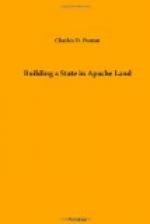I met an old friend at the Mission called “Buckskin Alick,” who had lived there all through the war without reading a newspaper or changing his clothes. As nails were scarce, Buckskin Alick had constructed a mill held together by rawhides, and was grinding wheat for the Papagos. In the meantime he had taken up with a Papago girl, to the scandal of the tribe. The priests told him he must marry the girl or leave. He appealed to me for protection, but I told him I had resigned my sacerdotal functions to the priest. He married the girl, and kept the mill.
In 1863 a considerable number of prospectors had come into Arizona, mostly from the California side, on account of discoveries of gold on the Hassayamp. Old Pauline Weaver was the discoverer, as he had been a trapper and pioneer since 1836. His name is carved on the walls of the Casa Grande with that date.
The gold washers there were doing very well, and ranches began to be established on the river. But the Apaches were not inclined to leave the settlers in peace when they had some fine horses and mules, and some fat cattle. So the Tonto Apaches made a raid on the Hassayamp, and carried off nearly all the stock.
King Woolsey had come into the country then, and was a prominent man among the settlers, and undoubtedly a very brave one; so he raised a company to go after the Tontos. (As every one knows, “tonto” means “fool.”)
There were not more than twenty-five men, including some friendly Maricopas. They were well armed, but their commisariat consisted principally of panole and jerkey.
They followed the Indians across the Verde to a place about half way between Globe and the Silver King, where they came to a parley. The tanks there are surrounded by rough ledges of basalt rocks, and the country in the vicinity is covered by scoriae, as though a volcano had vomited the refuse of the subterranean world to disfigure nature.
The Indians came in slowly for a talk, but were insolent and defiant. Delshay, the Tonto chief, demanded a blanket and some coffee and whisky. The Americans had neither coffee nor whisky for their own use, and he was quite put out about it, but partook of panole and jerked beef.
The parley was very unsatisfactory, as the Indians were surly, and made demands which it was impossible to grant. There were about twenty-five Indians at the council, and fifty or more on the surrounding ledges. As the Indians became more hostile the situation became more serious, and it was evident to the Americans that they were surrounded, and in imminent danger of massacre.
Woolsey was not only a brave but a very intelligent man, and he saw at once that either the Americans or the Indians were to be slaughtered, so he said: “Boys, we have got to die or get out of this. Each of you pick out your Indian, and I will shoot the chief for a signal.”
The fusillade commenced, and all the Indians that could run stampeded. The only American killed was Lennon, a half brother of Ammi White, my Indian agent at the Pima villages.




